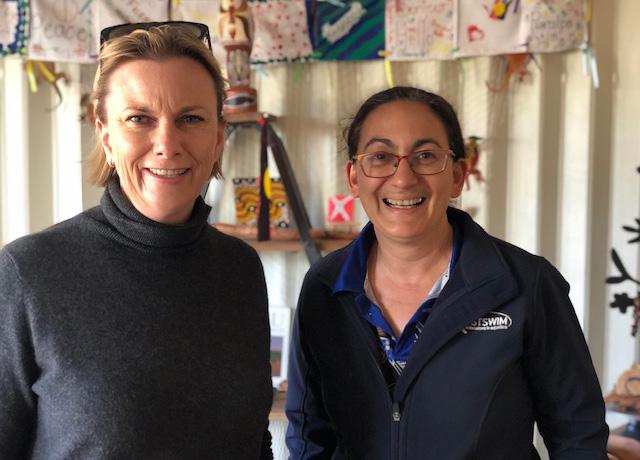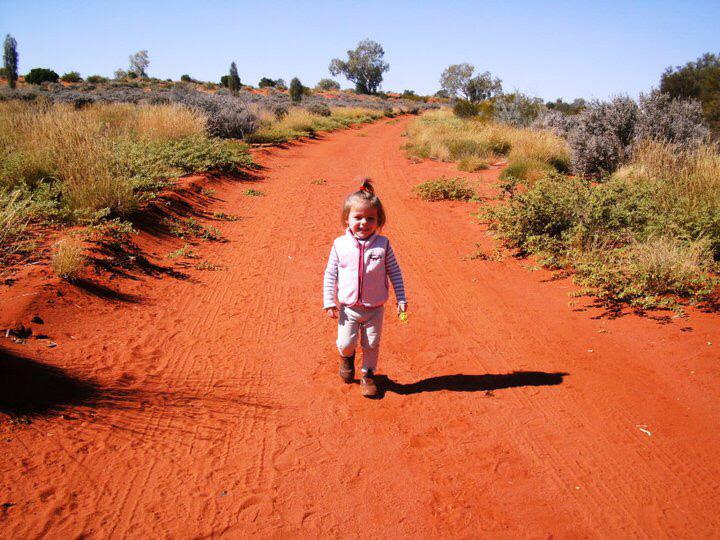
10 minute read
MEET THE MEMBER - YULARA CHILD CARE CENTRE
BY CAROLIN WENZEL
Imagine living and working in one of the most remote locations in central Australia. One day you are visited by a local sand goanna named George, and the next HRH Prince William and Kate, the Duke and Duchess of Cambridge, drop by.
Advertisement
These are the extremes of daily life at Yulara Child Care Centre, in the town that services the Ayers Rock Resort. It’s situated 26 km from Uluru in Kata Juta National Park near the Mutitjulu community in the Ngaanyatijarra Pitjantjatjara Yankunytjatjara NPY lands of the Northern Territory.
Yulara the town is run by the Indigenous Land and Sea Corporation, Voyages Ayers Rock Resort. Most people in the town work at the resort in hospitality, retail, emergency services, the airport or at the health clinic.
“The Yulara community is transient and very international,” explains Yulara Child Care Centre Director Renata Harris. “People come from Europe, the UK, the Philippines and South East Asia to work at the Resort. We have two visiting doctors and remote area nurses. There’s also a small primary school with 40-60 children from preschool to year 6. After that they join ‘school of the air’, or go to boarding school.”
Having established relationships many years ago, Renata knows the Mutitjulu community well. She also set up and ran a community creche at Docker River (two and a half hours drive west of Yulara) before taking over here eight years ago when her daughter, Olivia, was two years old.
“Since Uluru and the Park were handed over to the NPY communities, and the Resort established an Indigenous Training Academy, Aboriginal employment has risen from just 1% to around 40%. So, at the Child Care Centre we now have children from the Mutitjulu community and also from indigenous staff who have come from other states to work in the national park and the resort. “When I first got here in 2011, only two of the 25 children were Aboriginal. There was no acknowledgement of country and no cultural artefacts or local artwork. One of the first things I did was to revamp the foyer to make if feel more respectful of place,” says Renata.
RESPECTING PLACE The children were invited to choose Aboriginal art from the local gallery and art auctions to decorate the space. The centre now has a beautiful painting of the Seven Sisters – the dreaming story of the Southern Cross – by a local Mutitjulu artist, and another of a sand goanna.
“When we take the children out walking, we teach them the local words in language for the animals we see, read about or sometimes even get to eat,” explains Renata. “Tjala is the word for honey ants and Maku is witchetty grubs.”
On excursions and walks, everybody needs to take care. The educators teach the children to stop and look carefully - you can’t just lift rocks. There are Mulga and Western Brown snakes that are highly venomous; scorpions and centipedes that come up out of the ground every time it rains, and spiky or splintery plants like spinifex and mulga trees.
“When we walk everyone carries a stick, so we don’t touch anything with our hands. We always look for tracks and analyse them, we don’t see animals in the daytime unless they come in for water. We know there are spinifex mice, marsupial moles, and mala (bit like a wallaby) but we don’t see them because they only come out at night. But we often see tracks – made by rabbits, birds, beetles, and also poo – goanna poo is white, with chunks of fur probably from rabbits; dingo poo has a lot of fur, rabbits leave little balls and camels larger nuggets.”
The rule on excursions is for the children to wait behind the teacher, with one child designated as the leading child. If the group comes across a snake or lizard track, they circle the area so it isn’t ruined by their footprints. They walk in single file through spinifex and bushes, that way children are less likely to fall onto the spiked vegetation.
“One day I spotted something interesting,” recalls Renata. “ One of our Aboriginal children was the leading child. I asked him to make a circle around the area on the ground with his stick, then we all looked to see what was there.

“We saw three ants’ nests. There were little black ants, medium sized fire ants, and big red muncher ants – so that’s how we embed literacy and numeracy in everything we do.”
IMPROVING QUALITY When Renata arrived at Yulara, the service was struggling to meet minimum standards and was rated as Working Towards. At one stage there were no staff with any early childhood qualifications.
“The priority was health and safety, and literally keeping the children alive because of the dangerous outdoor environment, heat, and lack of effective policies and procedures. Then we worked on how to make it more inviting for the children so they would want to be here, and for the parents to feel comfortable. We chipped away, little by little.”
Eight years later there are eight staff, four of whom identify as Aboriginal. Two have a Certificate III and are working towards a Diploma, one has a teaching Diploma from New Zealand, another has a Bachelor of Education and is halfway through her Early Childhood Diploma. Renata is degree qualified with training in Forest School, Nature Pedagogy with Claire Warden, Nature Play and playground design.
One of Renata’s early recruits, Aimee Williams from western NSW, is one of the Aboriginal educators. Aimee was working in hospitality when Renata discovered she had early childhood qualifications and offered her a job at Yulara in 2014. Aimee is pleased to see a real improvement in how Aboriginal and Torres Strait Islander culture is discussed and reflected at the centre.
"Five years ago there were staff who didn’t recognise the Torres Strait Islander flag,” recalls Aimee. “Now we are having more conversations with educators and our families about our culture and how we can bring it into the program.


"We work really well with the Aboriginal families from the Mutitjulu community to come up with experiences for the children around special occasions such as NAIDOC week.”
Another educator, Fiona, has developed resilience from overcoming the very real challenges of working in such a remote location. Fiona says that the rapidly changing social and physical landscape can affect enrolments, staffing and resources, and that time has been the best teacher in learning to be much more adaptable, resilient and innovative. The guidance and years of experience that Renata brings to the service have also been invaluable.
Fiona appreciates how her teaching skills have developed beyond what she learned in her Diploma:
“One of the skills I am most proud of developing is the ability to recognise new opportunities to guide children’s learning throughout everyday activities, conversations and play. Much of my teacher education was based around planned lessons that met curriculum criteria. It has been an absolute joy and freeing experience to explore the Early Years Learning Framework and feel more comfortable with the idea of learning and developing whilst engaging in intentional and incidental play.
‘We offer a lot of risky outdoor play. We catch scorpions and centipedes, it’s the only way to learn which is the bitey

end, and we include reptile awareness as part of our program. The regulations are great, we can incorporate anything the children are interested in, including regular excursions. We just do a risk assessment and earn the trust of parents and children.”
Fiona and Renata attended workshop sessions with Nature Pedagogy expert Claire Warden and brought back many ideas that are now incorporated into both the physical environment and the approach to learning.
The biggest project was the creation of an outdoor nature play area.
NATURE PLAY GARDEN Constructing their new nature play garden was a wonderful challenge. The nearest Bunnings is four and a half hours drive away in Alice Springs! Everything was made with recycled and donated materials, including a balancing log, monkey bar area and climbing web.
“All we had here was red dirt and spinifex,” recalls Fiona. “That is not a safe environment for children on their own. They can injure themselves on the spiky plants, then there are the deadly snakes and wild camels. Even the centipedes can give a nasty bite. On top of that, we have extreme heat – over 40 degrees on many days, high UV and dust storms.”

Along with parents and members of the local community, they replaced existing plastic and metal with wooden structures, and added softer sand and recycled water. They softened the harshness with plants such as natives, herbs and citrus trees. They planted native trees and fruits and created a ‘creek’ by pouring a cement bed and installing a tank. They fill the creek with water from the rainwater tank at the start of the week and the children know it has to last all week.
“With the improved outdoor habitat, we get more visits from goannas, and they eat snakes and snake eggs. When George our resident sand goanna comes out, we all get up on a hill to watch him. One day he started digging a hole in the sand pit, and he dug up an egg and ate it whole.”’
With the increase in professional skills and the environment changes Renata introduced, their last assessment in 2017 resulted in an overall rating of Meeting, with Exceeding in quality areas 3 (physical environment), 6 (partnership with families and community) and 7 (Governance and Leadership).
A NECESSARY FOCUS ON ENVIRONMENTAL SUSTAINABILITY Renata tells us that the town’s infrastructure is operating at capacity, so they can’t add any extra load to the electricity, water or sewerage.
“I’m now an expert on recycling grey water, which is to be used sub terrain and on non-edible plants, and I know all about portable ‘medi-sinks’ and ‘smart sinks’.
“To help us recycle water we’ve overhauled our whole cleaning system. We don’t use chemicals, except for disinfectant in the high-risk areas like the kitchen, toilet and nappy changing area. We use Enjo microcloths, that clean just using a small amount of water.”
CHALLENGES Apart from finding qualified staff, funding is an ongoing challenge for Yulara Child Care Centre. They can’t rely on fees to cover all their costs, because the population is transient and the numbers of children attending fluctuates. They managed to get Sustainability Funding for five years
under the Community Child Care Fund, in addition to a capital grant which will help to build a new Eco-cabin, increase capacity to support under three year olds and improve the existing child care building. “I went to the Resort for extra support, because they run the town and it’s mainly their staff whose children attend,” says Renata. “I said, ‘Do you want your staff and families to just get by? Or do you want us to provide the best quality service we possibly can?
“Our families also struggle with the cost of living remotely, and in isolation from family and support networks. In recognition of these facts, Ayers

Rock Resort now makes considerable annual donations towards the ongoing operating costs of our small, very remote, ever evolving and extremely flexible service.”
Renata concludes: “To be able to make it work out here you need to be stubborn, flexible, and have energy but be realistic and do things a bit at a time.”











